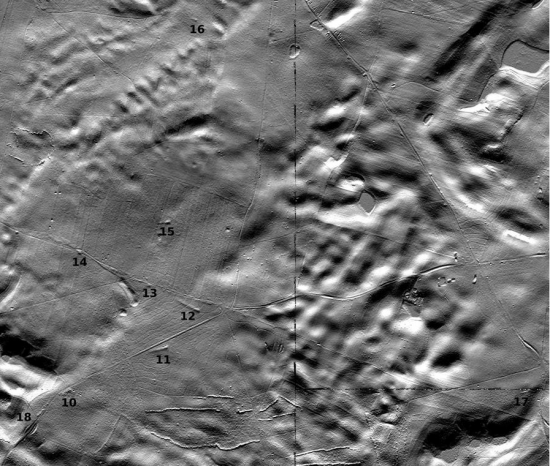PAP - Science and Scholarship in Poland
Source - http://scienceinpoland.pap.pl/en/news/news,408544,more-polish-pyramids---new-discoveries-of-archaeologists.html
 One of the tombs discovered with ALS near Dolice - present state (photo by M. Szydłowski).
One of the tombs discovered with ALS near Dolice - present state (photo by M. Szydłowski).
More than a dozen hitherto unknown monumental megalithic tombs, have been discovered near Dolice (Western Pomerania) by archaeologists from Szczecin. They are so-called Kujawy tombs, often referred to as "Polish pyramids" because of their monumental character.
These ground structures were built in the shape of an elongated triangle and surrounded with huge stone blocks. The width of the base ranged from 6 to 15 meters and length reached 150 m. The structures reached a height of 3 m. The mounds usually contained single burials. Tombs were erected by the Funnel Beaker Culture community from the fifth to the third millennium BC According to archaeologists, people buried in these tombs were associated with the elders of the tribe and clan.
The discovery was made in the framework research and conservation program concerning the megalithic tombs in Western Pomerania, carried out in the Department of Archaeology, University of Szczecin by Dr. Agnieszka Matuszewska in collaboration with Marek Schiller from Dębno.
"For our analyses we used the project ISOK (National Protection Computer System against extraordinary threats)" - explained Dr. Matuszewska. - "Thanks to the database we have created and systematically update, it was possible to select places for testing that method" - she added.
Analyses were made possible by the fact that one of the elements ISOK is the Geographic Information System (GIS) for entering, storing, processing and visualization of geographic data.
The shared data can be used by institutions not involved in the matters of safety in case of a crisis. Information obtained in this way are especially valuable for archaeologists, for whom the study of forest areas is particularly difficult - standard procedure of locating archaeological sites is based on fragments of pottery and other relics discovered on the surface of the earth.
These objects can be easily spotted on the arable fields, but in the forests the situation is much more difficult. The easiest way is to search for terrain forms, but before the ALS (airborne laser scanning) technology, which is also used within ISOK, this was virtually impossible. Scanning allows to "remove" trees from the resulting image and visualize only the terrain, which is a huge leap in the archaeological surveying.
After analysing data from ISOK, archaeologists selected places in the area, which they suspected of being megalithic structures. The system effectively located previously known structures, but also managed to discover several that were not on any list.
"The area near Dolic is undoubtedly the most interesting, we have selected at least a dozen potential megalithic tombs. In the course of verification in the field we have clearly confirmed the presence of 18 Kujawy type megalithic tombs, a much higher number than previously known from the literature" - said Dr. Matuszewska. Similar structures have been located in Skronie Forest near Kołobrzeg. 4 more megalithic tombs have been discovered near Płoszkowo - here archaeologists confirmed their suspicions in the field.
 Digital terrain model generated using data from airborne laser scanning (ALS), showing the megalithic tombs in the area of Dolice (prepared by M. Schiller).
Digital terrain model generated using data from airborne laser scanning (ALS), showing the megalithic tombs in the area of Dolice (prepared by M. Schiller).
 Digital terrain model generated using data from airborne laser scanning (ALS), showing 4 megalithic tombs in the area Płoszkowo (prepared by M. Schiller).
Digital terrain model generated using data from airborne laser scanning (ALS), showing 4 megalithic tombs in the area Płoszkowo (prepared by M. Schiller).
Discoveries were made using digital terrain models (DTM), three-dimensional mapping of the area prepared on the basis of ALS (airborne laser scanning). "The potential of this method is huge. First of all, it allowed to precisely locate previously known megalithic objects and, importantly, discover previously completely unknown tombs" - said Dr. Matuszewska. - "It is also possible to verify in the field all, even slightly preserved objects. As a result, we were able to identify them and document the degree of destruction. This is particularly important considering the aspect of the protection and conservation of forest areas, in particular the protection of monuments with their own of landscape forms" - she added.
Megalithic structures in Poland are preserved only in forest areas, having escaped destruction due to agricultural activities. The most famous "Polish pyramids" can be seen in Sarnów and Wietrzychowice, where their former shape has been reconstructed following archaeological research. All structures of this type are part of a Europe-wide trend of erecting great megalithic monuments at that time (V-III millennium BC), the most famous of which is the British Stonehenge.